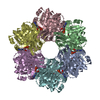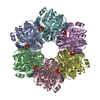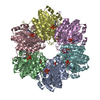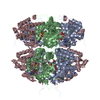+ Open data
Open data
- Basic information
Basic information
| Entry | Database: PDB / ID: 7s67 | ||||||
|---|---|---|---|---|---|---|---|
| Title | Extended conformation of daytime state KaiC | ||||||
 Components Components | Circadian clock protein kinase KaiC | ||||||
 Keywords Keywords | CIRCADIAN CLOCK PROTEIN / AAA ATPase / Circadian Oscillator / Kinase / Phosphatase | ||||||
| Function / homology |  Function and homology information Function and homology informationregulation of phosphorelay signal transduction system / negative regulation of circadian rhythm / entrainment of circadian clock / protein serine/threonine/tyrosine kinase activity / circadian rhythm / Hydrolases; Acting on acid anhydrides; Acting on acid anhydrides to facilitate cellular and subcellular movement / non-specific serine/threonine protein kinase / protein serine kinase activity / protein serine/threonine kinase activity / regulation of DNA-templated transcription ...regulation of phosphorelay signal transduction system / negative regulation of circadian rhythm / entrainment of circadian clock / protein serine/threonine/tyrosine kinase activity / circadian rhythm / Hydrolases; Acting on acid anhydrides; Acting on acid anhydrides to facilitate cellular and subcellular movement / non-specific serine/threonine protein kinase / protein serine kinase activity / protein serine/threonine kinase activity / regulation of DNA-templated transcription / magnesium ion binding / ATP hydrolysis activity / DNA binding / ATP binding / identical protein binding Similarity search - Function | ||||||
| Biological species |  Synechococcus elongatus (bacteria) Synechococcus elongatus (bacteria) | ||||||
| Method | ELECTRON MICROSCOPY / single particle reconstruction / cryo EM / Resolution: 3.8 Å | ||||||
 Authors Authors | Sandate, C.R. / Swan, J.A. / Partch, C.L. / Lander, G.C. | ||||||
| Funding support |  United States, 1items United States, 1items
| ||||||
 Citation Citation |  Journal: Nat Struct Mol Biol / Year: 2022 Journal: Nat Struct Mol Biol / Year: 2022Title: Coupling of distant ATPase domains in the circadian clock protein KaiC. Authors: Jeffrey A Swan / Colby R Sandate / Archana G Chavan / Alfred M Freeberg / Diana Etwaru / Dustin C Ernst / Joseph G Palacios / Susan S Golden / Andy LiWang / Gabriel C Lander / Carrie L Partch /  Abstract: The AAA family member KaiC is the central pacemaker for circadian rhythms in the cyanobacterium Synechococcus elongatus. Composed of two hexameric rings of adenosine triphosphatase (ATPase) domains ...The AAA family member KaiC is the central pacemaker for circadian rhythms in the cyanobacterium Synechococcus elongatus. Composed of two hexameric rings of adenosine triphosphatase (ATPase) domains with tightly coupled activities, KaiC undergoes a cycle of autophosphorylation and autodephosphorylation on its C-terminal (CII) domain that restricts binding of clock proteins on its N-terminal (CI) domain to the evening. Here, we use cryogenic-electron microscopy to investigate how daytime and nighttime states of CII regulate KaiB binding on CI. We find that the CII hexamer is destabilized during the day but takes on a rigidified C-symmetric state at night, concomitant with ring-ring compression. Residues at the CI-CII interface are required for phospho-dependent KaiB association, coupling ATPase activity on CI to cooperative KaiB recruitment. Together, these studies clarify a key step in the regulation of cyanobacterial circadian rhythms by KaiC phosphorylation. | ||||||
| History |
|
- Structure visualization
Structure visualization
| Movie |
 Movie viewer Movie viewer |
|---|---|
| Structure viewer | Molecule:  Molmil Molmil Jmol/JSmol Jmol/JSmol |
- Downloads & links
Downloads & links
- Download
Download
| PDBx/mmCIF format |  7s67.cif.gz 7s67.cif.gz | 496.4 KB | Display |  PDBx/mmCIF format PDBx/mmCIF format |
|---|---|---|---|---|
| PDB format |  pdb7s67.ent.gz pdb7s67.ent.gz | 413 KB | Display |  PDB format PDB format |
| PDBx/mmJSON format |  7s67.json.gz 7s67.json.gz | Tree view |  PDBx/mmJSON format PDBx/mmJSON format | |
| Others |  Other downloads Other downloads |
-Validation report
| Summary document |  7s67_validation.pdf.gz 7s67_validation.pdf.gz | 1.9 MB | Display |  wwPDB validaton report wwPDB validaton report |
|---|---|---|---|---|
| Full document |  7s67_full_validation.pdf.gz 7s67_full_validation.pdf.gz | 2 MB | Display | |
| Data in XML |  7s67_validation.xml.gz 7s67_validation.xml.gz | 88 KB | Display | |
| Data in CIF |  7s67_validation.cif.gz 7s67_validation.cif.gz | 127 KB | Display | |
| Arichive directory |  https://data.pdbj.org/pub/pdb/validation_reports/s6/7s67 https://data.pdbj.org/pub/pdb/validation_reports/s6/7s67 ftp://data.pdbj.org/pub/pdb/validation_reports/s6/7s67 ftp://data.pdbj.org/pub/pdb/validation_reports/s6/7s67 | HTTPS FTP |
-Related structure data
| Related structure data |  24852MC  7s65C  7s66C C: citing same article ( M: map data used to model this data |
|---|---|
| Similar structure data |
- Links
Links
- Assembly
Assembly
| Deposited unit | 
|
|---|---|
| 1 |
|
- Components
Components
| #1: Protein | Mass: 58084.781 Da / Num. of mol.: 6 / Mutation: S431A T432E Source method: isolated from a genetically manipulated source Source: (gene. exp.)  Synechococcus elongatus (bacteria) / Gene: kaiC, Synpcc7942_1216, see0011 Synechococcus elongatus (bacteria) / Gene: kaiC, Synpcc7942_1216, see0011Production host:  References: UniProt: Q79PF4, non-specific serine/threonine protein kinase #2: Chemical | ChemComp-ATP / #3: Chemical | ChemComp-MG / #4: Chemical | ChemComp-ADP / Has ligand of interest | Y | |
|---|
-Experimental details
-Experiment
| Experiment | Method: ELECTRON MICROSCOPY |
|---|---|
| EM experiment | Aggregation state: PARTICLE / 3D reconstruction method: single particle reconstruction |
- Sample preparation
Sample preparation
| Component | Name: Compressed state hexamer of nighttime state phosphomutant KaiC (KaiC-EA) Type: COMPLEX / Entity ID: #1 / Source: RECOMBINANT | |||||||||||||||||||||||||||||||||||
|---|---|---|---|---|---|---|---|---|---|---|---|---|---|---|---|---|---|---|---|---|---|---|---|---|---|---|---|---|---|---|---|---|---|---|---|---|
| Molecular weight | Value: 0.350 MDa / Experimental value: NO | |||||||||||||||||||||||||||||||||||
| Source (natural) | Organism:  Synechococcus elongatus (bacteria) Synechococcus elongatus (bacteria) | |||||||||||||||||||||||||||||||||||
| Source (recombinant) | Organism:  Plasmid: pET-28b | |||||||||||||||||||||||||||||||||||
| Buffer solution | pH: 7.4 | |||||||||||||||||||||||||||||||||||
| Buffer component |
| |||||||||||||||||||||||||||||||||||
| Specimen | Conc.: 6 mg/ml / Embedding applied: NO / Shadowing applied: NO / Staining applied: NO / Vitrification applied: YES | |||||||||||||||||||||||||||||||||||
| Specimen support | Details: Graphene-coated grids were made hydrophilic via treatment by UV/ozone cleaner. Grid mesh size: 300 divisions/in. / Grid type: UltrAuFoil R1.2/1.3 | |||||||||||||||||||||||||||||||||||
| Vitrification | Instrument: HOMEMADE PLUNGER / Cryogen name: ETHANE / Humidity: 95 % / Chamber temperature: 277.15 K Details: Grids with applied sample were manually blotted with filter paper (Whatman No.1) for 3 seconds in a 4 C cold room before plunge freezing in liquid ethane cooled by liquid nitrogen. |
- Electron microscopy imaging
Electron microscopy imaging
| Experimental equipment |  Model: Talos Arctica / Image courtesy: FEI Company |
|---|---|
| Microscopy | Model: FEI TALOS ARCTICA |
| Electron gun | Electron source:  FIELD EMISSION GUN / Accelerating voltage: 200 kV / Illumination mode: FLOOD BEAM FIELD EMISSION GUN / Accelerating voltage: 200 kV / Illumination mode: FLOOD BEAM |
| Electron lens | Mode: BRIGHT FIELD / Nominal magnification: 36000 X / Calibrated magnification: 43478 X / Nominal defocus max: -2000 nm / Nominal defocus min: -500 nm / Calibrated defocus min: -500 nm / Calibrated defocus max: -2000 nm / Cs: 2.7 mm / C2 aperture diameter: 70 µm / Alignment procedure: COMA FREE |
| Specimen holder | Cryogen: NITROGEN / Specimen holder model: FEI TITAN KRIOS AUTOGRID HOLDER / Temperature (max): 70 K / Temperature (min): 70 K |
| Image recording | Average exposure time: 6.2 sec. / Electron dose: 40.3 e/Å2 / Detector mode: COUNTING / Film or detector model: GATAN K2 SUMMIT (4k x 4k) / Num. of grids imaged: 1 / Num. of real images: 1541 |
| Image scans | Sampling size: 5 µm / Width: 3710 / Height: 3838 / Movie frames/image: 62 / Used frames/image: 1-62 |
- Processing
Processing
| EM software |
| ||||||||||||||||||||||||||||||||||||||||
|---|---|---|---|---|---|---|---|---|---|---|---|---|---|---|---|---|---|---|---|---|---|---|---|---|---|---|---|---|---|---|---|---|---|---|---|---|---|---|---|---|---|
| CTF correction | Details: CTF Refinement performed in Relion / Type: PHASE FLIPPING AND AMPLITUDE CORRECTION | ||||||||||||||||||||||||||||||||||||||||
| Particle selection | Num. of particles selected: 427620 | ||||||||||||||||||||||||||||||||||||||||
| Symmetry | Point symmetry: C6 (6 fold cyclic) | ||||||||||||||||||||||||||||||||||||||||
| 3D reconstruction | Resolution: 3.8 Å / Resolution method: FSC 0.143 CUT-OFF / Num. of particles: 89892 / Symmetry type: POINT | ||||||||||||||||||||||||||||||||||||||||
| Atomic model building | Protocol: RIGID BODY FIT | ||||||||||||||||||||||||||||||||||||||||
| Atomic model building | PDB-ID: 3K0C Accession code: 3K0C / Source name: PDB / Type: experimental model |
 Movie
Movie Controller
Controller











 PDBj
PDBj







